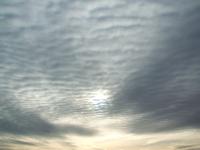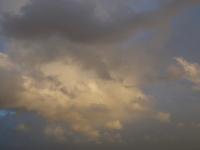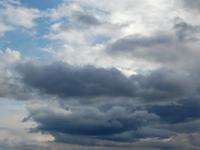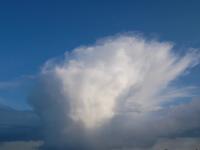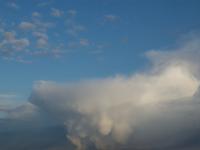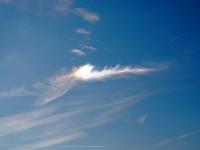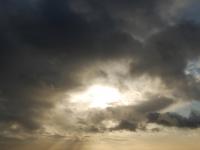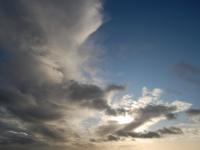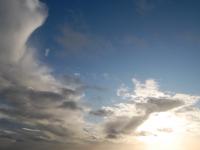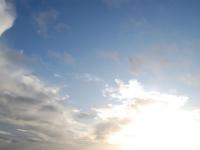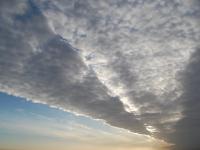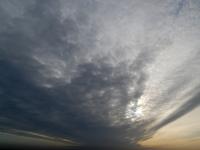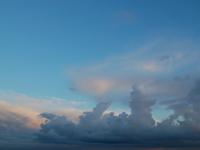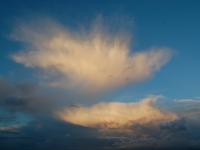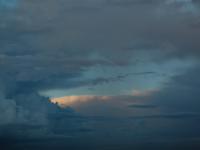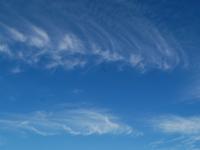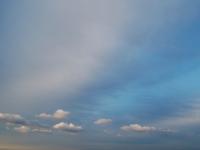Cirrus Light - Harvey Composing with Contemporary Music (Teachers) >
Composing inspired by the changing colours and shapes of clouds. Inspired by Cirrus Light by composer Jonathan Harvey.
Programme Note
The starting point for Cirrus Light was the long hours sitting in my wheelchair gazing at the summer sky. The cirrus clouds, which are so high, well formed and slow changing, were often illuminated by a beautiful light. The clarinet searches the sky for them.'
Composer, Jonathan Harvey
Composed for solo clarinet, Cirrus Light is made up from five distinct and characterful musical gestures:
- a muttering semi quaver figure in the low register
- 'other-worldly' high long notes with glissandi in between
- 'bird like' chips which leap around
- repeated notes using alternative fingerings and different rhythms
- an 'almost toneless' figure, sometimes slow sometimes fast, which moves up and down arpeggios

Introduction
In this resource the children will either create a solo piece for themselves to perform or a group piece inspired by clouds. To start with the children will think about the characteristics of different types of clouds (shape, size, colour, density) and create musical gestures to describe different clouds. Then they will think about how clouds change and transform over time as an analogy for creating variations of their original cloud gestures. The children will then be guided to structure ideas these into longer compositions.
Please listen to Cirrus Light and read the Music Maze Guidance before starting.
Learning Objectives
- To be able to create a musical gesture from an extra-musical idea (clouds)
- To be able to transform a musical gesture through changing musical elements such as dynamics, texture, pitch contour and timbre
- To be able to structure the above musical ideas into a longer composition
- To develop an understanding of Cirrus Light
Resources Needed
- Tuned percussion and untuned percussion
- The children’s own instruments if appropriate
- A copy of the score that can be found on this link (optional)
- A cloud identification book (optional)
How can we move from extra musical ideas to musical ideas?
Play your group the recordings of the five cloud gestures from Cirrus Light. Ask the children to think about and describe the cloud each gesture might have been representing. If your group reads notation show them the five different gestures on the score.
Muttering semi quaver figure in the low register
'Other-worldly' high long notes with glissandi in between
Bird like' chirps which leap around
Repeated notes using alternative fingerings
An 'almost toneless' figure, sometimes slow sometimes fast
All excerpts are performed by BCMG Clarinetist Jack McNeil
Then listen to whole piece, noticing how Jonathan Harvey uses the same ideas but each time they have been developed or transformed in some way. Can they notice how ideas have been developed and transformed?
From Clouds to Sounds
With your group look at some clouds! You can either do this by looking at real clouds, using the attached photographs (also on the next page), or using photographs or videos that you or the children have sourced/taken/filmed. You might want additionally, to identify the clouds and give them their proper names.
Choose 3 or 4 clouds that are characterful and distinct from each other by type, size, colour, density etc. With the group find some words to describe the qualities of each cloud.
Ask the children to, in 1s, 2s or 3s, to think of ideas as to how these qualities could be expressed musically as a gesture. They need to think about:
- The overall musical shape of their idea
- How loud or quiet the sound gesture will be
- Whether it is a fast or slow
- What instruments might be used
- How many instruments - just one person, everyone in the group or just a few people
- What kinds of sounds they want from that instrument(s)
If you have breakout spaces the children could do some experimenting with sounds too.
Remind the children that they are not creating a whole piece but just thinking of a single musical gesture/idea that they will develop later.
Sit in a circle with a range of tuned and untuned percussion instruments to hand. Try out different ideas for each cloud, asking the child(ren) whose idea it is to map it out (i.e. decide who is playing what and how) with the whole group. It is important to note that the ideas/gestures should have everyone playing in unison or in sequence rather than in layered different parts. Perform and refine. Repeat this with the other clouds. You might want to model this first with an idea of your own.
If working with children who all play melodic instruments, encourage them to experiment on their own instruments as they plan. The idea with this kind of group is that they create a solo piece for themselves rather than a piece for the whole group.
Photographs of Clouds






Transforming Clouds 1
With the group think about all the different ways clouds change and transform over time. You could use the attached cloud photos as a stimulus. Ask them to think in pairs before sharing back to the group. For example clouds:
- Gradually change from one shape to another
- Change colour with the changing light
- Move further apart or closer together
- Grow in size
- Break apart
- Merge with other clouds
Discuss with the group about how they could represent these changes musically by transforming or developing a musical gesture.






Transforming Clouds 2
If space allows break into 4 different groups in four space and rotate around these activities. If not, work as a whole group doing one activity at a time.
Clouds changing colour
Chose and play one of the musical cloud gestures as a group. As a group, play around with the instrumentation, timbre and articulation to change ‘colour’ of the musical gesture, like the light changes the colour of a cloud. Explore different colours, lightening and darkening the sound as a group though not always with all the instruments playing.
Clouds gradually changing shape
Chose and ask one person to play one of the musical cloud gestures. Sticking to shape of the gesture only, ask the next person in the circle to play the original idea but change it slightly as if it was a cloud, almost imperceptibly, changing shape. This game is a little bit like a musical game of Chinese Whispers. The next person then takes the second idea and again changes it slightly. Ask the group to notice how the idea was changed. And so on around the circle.
OR Chose and play one of the musical cloud gestures as a group. Instead of going round the circle making small changes, ask the group for suggestions how the original gesture might be changed to reflect its change in shape and then try it with the whole group. And then do this again with the modified gesture and so on.
Clouds expanding
Chose and play one of the musical cloud gestures. As a group, experiment using dynamics and durations to grow and stretch the idea, like a cloud that expands in size but maintains its overall shape.
Density of clouds
Sometimes similar clouds are spaced out far apart and sometimes they are close together. Chose and play one of the cloud musical gestures. In this activity each person in the group plays the whole cloud gesture independently of the others. Ask each person to play the gesture 3 times within the space of 10 seconds. Someone can show the time passing by holding hands far apart and bringing them together at the end of the 10 seconds. Now try this again but within 20 seconds and so on. You may need to change the timings here depending on how many people are in each group.
Another way of doing this is to ask people to independently play the gesture after a starting cue and then wait 5 seconds before playing it again and then counting another 5 seconds. Then try it but counting 10 seconds between each iteration and so on. This is good to do with your eyes closed to feel the effect of the changing spaces in the music.
With a group of instrumentalists who play melodic instruments, play the games as a whole group but also ask them to explore the ideas as individuals.
Composing Cloud Compositions
At this point the children can either:
(a) continue to work in groups using the material already generated (original gestures and their transformations) to create/plan a piece for the whole group.
or (b) Work individually to create a solo piece.
If you decide that you would like the children to work individually it might be a good idea to encourage them to spend some time finding a range different timbres/colours on their own instrument through extended techniques and different articulations.
Either way, the task now is to select and structure the original musical gestures and their transformations into a longer compositions.
In Cirrus Light by Jonathan Harvey the ideas are sequential rather then layered. In keeping with the piece ask the children to also create sequential pieces rather than ones which have multiple layers. It may help if the groups/individuals use graphic notation to help remember and organise their ideas. Ask the children to think about:
- Which cloud musical gesture they would like to start their composition with?
- What ideas/concepts are going determine which transformations they are going to use and how they are going to organise the different gestures. e.g. is there a narrative or is there a more abstract idea behind the shape/journey of the music?
Try out the pieces with the whole group and refine. Below are examples created by children at Music Maze.
